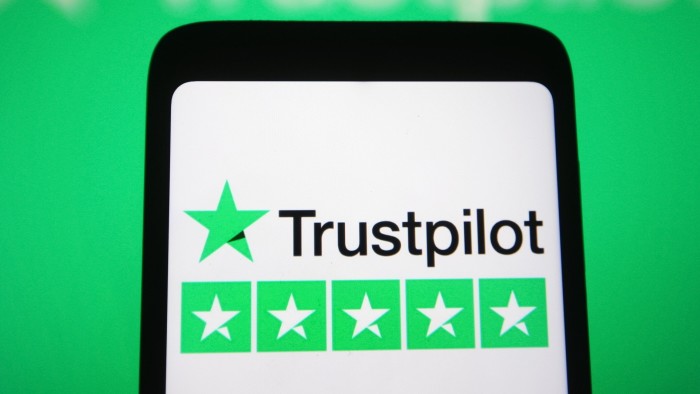Unlock the Editor’s Digest for free
Roula Khalaf, Editor of the FT, selects her favourite stories in this weekly newsletter.
Browsing one-star reviews on Trustpilot is a great way to experience vicarious outrage on behalf of overcharged or underserved customers. Going by its own pricey valuation, though, shareholders are awarding the online reviewer the full five stars. Value depends on perspective — or geography, in this case — but a more moderate rating would give an untested model some leeway.
Shares in Trustpilot, which produced its first net profit last year, surged as much as 13 per cent on Tuesday after a trading update beat expectations and led the group to forecast a 14 per cent full-year ebitda margin, up from just over 11 per cent, if stock option costs and one-offs for transactions and restructuring are taken out.
The gains pushed its shares back above the 265p price at which it went public in 2021, and nudged its market value over $1bn. It also drove the share price to the equivalent of more than 70 times this year’s forecast earnings per share, and a punchy 54 times forecasts for 2027.
Trustpilot makes its money from selling companies a tiered ability to monitor and interact with their customers’ reviews on its site. Its value lies in its independence: consumers give their reviews freely and use the site to check out companies. For small enterprises, a good rating helps build credibility. For the largest, Trustpilot offers data analytics while its rating can help managers push a customer service ethos. Google and Amazon are the competitors that spring to mind, but for each, ratings form a small part of other offerings, be that maps or a marketplace.
How to value the company? Consider it a middling if up-and-coming member of the FTSE 250, and a multiple of 70 puts it head and shoulders above any other mid-cap stock. The next highest are Raspberry Pi, maker of tiny computers, and designer Burberry, both with 40-something multiples. More comparable companies, such as property portal Rightmove or software provider Sage, trade on 26 times, though both can also be considered mature businesses.
US investors make up about two-fifths of Trustpilot’s investor base, roughly double their presence a year ago, which may help explain the optimistic pricing. Rank Trustpilot among US companies offering subscription software services, and its valuation sits towards the middle, albeit in a range that runs from multiples of more than 200 for data analytics group Palantir Technologies, down to 20 times for customer relationship enabler Salesforce.
Markets work, like customer review aggregators, because contributors have different opinions and must meet in the middle. Seen from the US, Trustpilot’s rating — meaning its valuation — looks more like a three-star affair. The company shows no sign of wanting to ship its listing across the Atlantic. But as its users know, those unsatisfied with the service they are getting can always take their business elsewhere.
jennifer.hughes@ft.com
https://www.ft.com/content/3e8d1a91-75fe-4247-9341-3f8abdc12136


